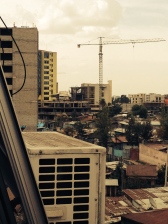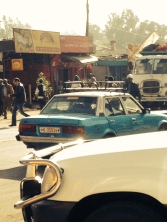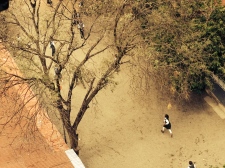On Sunday I left Cape Town to travel to Addis Ababa – a soul journey back to a place of my youth – and to engage with other artists. I was last in Addis in January 1981 when we left to return to Uganda. As I boarded the Ethiopian Airlines plane in Johannesburg I realised that the last time I boarded a plane to Addis things were very different. The air hostesses walked around the plane with a plate of sweets before take off and landing, to give you something to suck so your ears would not block. In those days we were still able to go and visit the cockpit to see how the pilots fly the planes. Smoking was still allowed in airplanes, and there was a smoking and a non-smoking area. We still got little packs with socks, eye pads and toothbrushes on airlines. And in the toilets, in the airplanes, there was soap and lotion. And if you went on a long transatlantic flight, chances are you would have your toilet bag with you in the plane. It was a very different time.
There was a buzz in the plane – passengers talking to each other, laughing… it was not like some of the flights I have been on where everyone seems to mind their own business and everything feels so impersonal in the plane. I think many people on the flight knew each other, or got to know each other, and the Ethiopian Airlines staff created an atmosphere that was just pleasant. I kept feeling as if I was in someone’s lounge.
We arrived in Addis at about 9 pm local time. As we taxied down the runway, I remembered how Daddy used to wait to hear the plane flying over our house before he got into the car to come to the airport. We lived in Bole, very close to the airport. I thought I might be able to see where we lived as we drove out of the airport. I noticed, as we got out of the bus that the airport building was bigger than it had been. And as we drove out of the airport the empty spaciousness that I remembered along Bole Road was filled with buildings, cars and people – tall buildings with multiple storeys. The road had also grown – it was much wider than it had been. I think that the houses in the area, or many of them, were broken down to make way for the new buildings. Our hosts said that all this development happened in the last 6 to 7 years. Addis is growing very fast.
But somethings don’t change – at least not totally. The little blue and white taxis that drove up and down the streets in 1977 are still there – a crucial mode of public transport. They have changed just a little. In 1977 most of them were Fiats but now they are Datsuns or Toyotas. Then there is the quirkyness of Addis – with its upmarket housing next to low-cost housing. In this city people live side by side – they always have. I remember when we first came here we were surprised at the shacks that were so close to the Palace. The suburbs don’t really exist. It’s a conscious plan to enable even development, and to ensure that the rich and poor are integrated. The discomfort that people from the suburbs have when they go to the poorer parts of town in other countries does not exist – and I like that.





